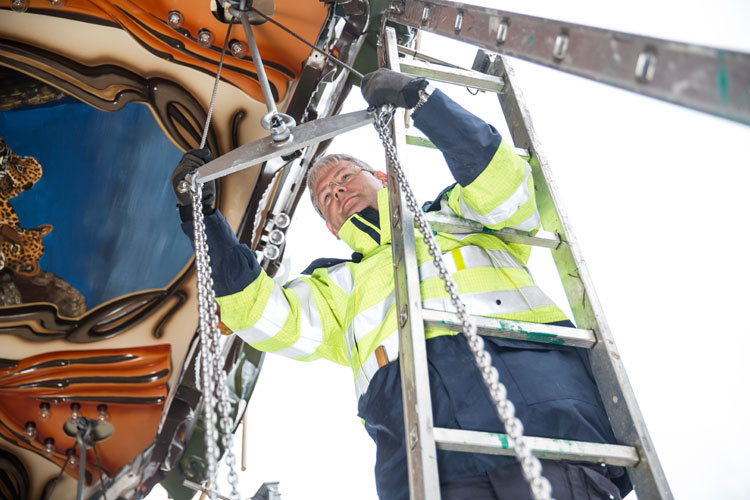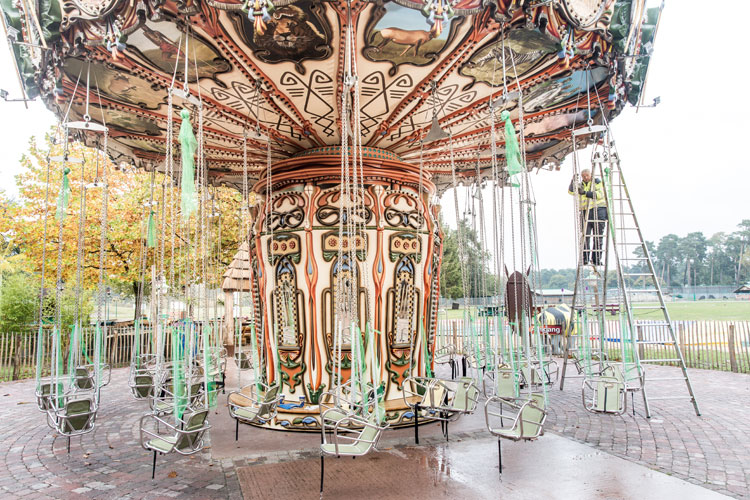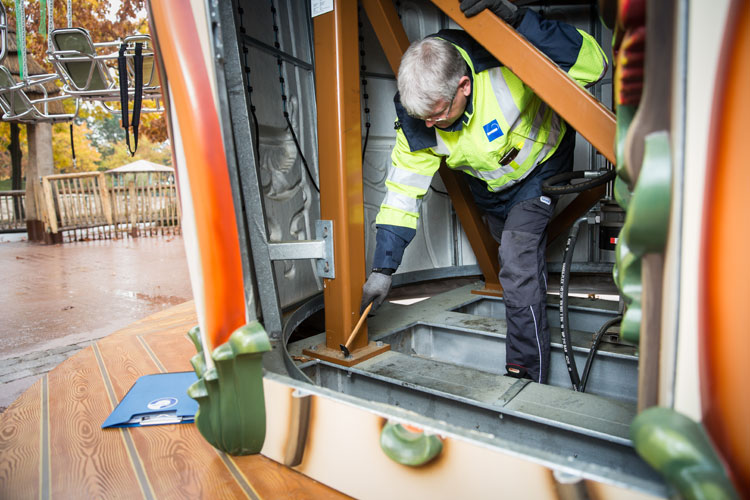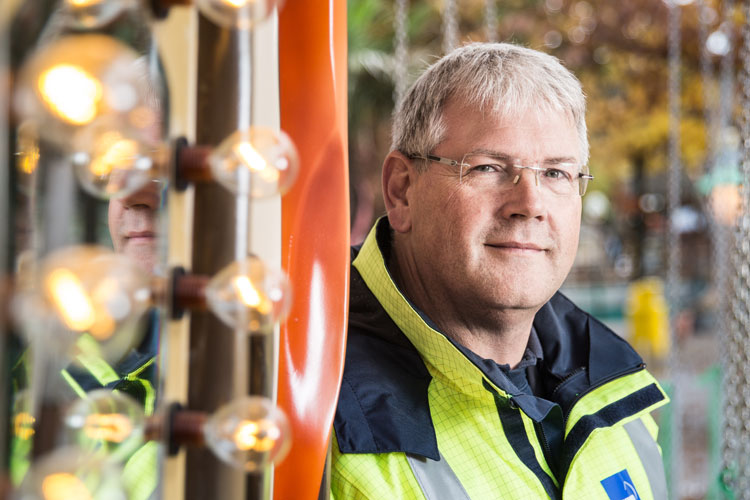25 November 2016
Millions of people around the world experience the fun and thrills of roller coasters, carousels and other fairground rides every year. They need to be confident that the equipment is always safe. The safari park in the German town of Stukenbrock has for 20 years been relying on the experience of the experts from TÜV NORD.
With its proudly puffed-out chest, the White Lion sits 12 metres above the ground on the roof of the colourful swing ride known as the Wave Swinger. If the mighty animal were real, it would no doubt snap at the strange man on the ladder who has dared encroach on its territory at this dizzying height to check the seat mounts. Fortunately, the lion is merely a deceptively realistic imitation model made of cold foam and polyester. But its real-live relations do prowl their large enclosure just a stone’s throw away from the swing ride here in the Stukenbrock Zoo Safari Park. The park even hosted the two international stars Siegfried and Roy when the first two individuals of this rare species of predatory cat first arrived exactly 20 years ago. Since then, managing director Fritz Wurms and his colleagues have rejoiced nearly every year in the arrival of new generations in the predator enclosure. “We have the largest breeding programme for white lions in Europe,” explains the head of the long-standing family business.
© Franz BischofTÜV NORD employee Michael Krah checks the suspensions of the seats at the chairoplane.
Out and about on every continent
1996 was not just the beginning of the white lion era in Stukenbrock but also marked the start of collaboration with TÜV NORD. Michael Krah - the man on the ladder - is responsible for “mobile constructions” and, consequently, for the inspection of funfair rides of all kinds. Sounds like a real dream job - but it isn’t for the squeamish. This is because the work of the inspectors often takes place in tight and dark spaces. Or under the open sky - and that whenever the season ends for the theme parks. It’s often rainy and cold. But this doesn’t detract from the enthusiasm of the native of Essen for his job. “We certainly don’t have what you would call a common-or-garden job, and we’re seen as a bit of an oddity at the TÜV,” Krah explains.
And yet, the safety inspection of amusement park rides in Germany has a venerable tradition. It was back in 1929 that inspection books, which set the technical standards for the equipment, were first introduced in Germany. The long-standing experience of TÜV NORD in this field is in demand not only in Germany, but also internationally. “During my 16 years at TÜV NORD I’ve tested fairground rides on every continent,” reports the qualified electrical engineer, who has only just returned from a business trip to Latin America. “The exciting thing about this job is that all the engineering disciplines are represented. We need expertise in the fields of steel construction and electrical, pneumatic and hydraulic engineering,” says Krah.
Good planning is half the battle for approval
In Germany, the operation of such rides is subject to building regulations - no matter whether they are only temporarily in use at a festival, or permanently set up at an amusement park. To ensure that approval for the rides is not withdrawn, Safari Park Director Fritz Wurms must submit the annual test reports to the local buildings department. This also applies to brand-new rides, such as the “Africa Swing” wave swinger, by way of preparation for the appropriate acceptance tests.
© Franz BischofThe "Africa Swing" chairoplane is the newest ride in Safaripark Stukenbrock.
Centrifugal forces and waves
Plant manager Manuel Wesemann explains the functional principle behind the new family attraction, known as a wave swinger: “First of all, a hydraulic cylinder lifts the roof of the ride via a cable. At a certain height, the top of the ride to which the gondolas are attached tilts to one side.” When in operation the roof structure spins at twelve revolutions per minute in a clockwise direction, while the lower part of the construction turns at four revolutions per minute in the opposite direction. This creates a wave motion, which is the special attraction of this kind of amusement park ride. “The steel structures of this kind of equipment must be able to withstand high loads due to the centrifugal forces,” explains Krah, as he inspects the massive steel girders with a torch in the cramped interior of the ride. A large part of the mechanical rotary forces which flow through the central structure into the ground is concentrated on them, and this is why the expert pays particularly close attention to the welded seams of the struts, which is where any material fatigue is most likely to show up. “The manufacturer installs just as much steel as is needed but not necessarily more. And so, all the supporting elements must be in good condition. After all, this ride runs for 210 days in the year and carries thousands of people every season.”
Testing with all of the senses
And yet, if you are looking to generate a complete picture of the functions of a fairground ride, it isn’t nearly enough to rely only on the evidence of your eyes. “All your senses need to be really sharp,” explains the TÜV NORD tester as he whacks the bolts on a screw connection with a hammer. “Sounds metallic. That’s good. To me, a dull sound from a positive-locking joint would indicate that the screws are too loose.” Krah then uses a narrow ladder in the dark central structure to climb up onto a small platform. Here is the technical heart of the system: the hydraulic cylinders for the lifting motion and the actual motor of the carousel. The rotary movement is generated by an electric motor which drives a ball-bearing slewing ring. “There’s no sign of grease leaks. This means that the pinion is resting flush on the sprocket. That’s how it should be,” says the inspector with satisfaction as he emerges back into the daylight.
© Franz BischofListening to the hammering Micheal Krah can hear whether the bolts are fixated on the steel carriers.
His next journey leads him to the control stand of the ride, where all the electronic controls are housed. Before Michael Krah connects his measuring instrument, he first of all scrutinises all the equipment with a practiced eye. Is there any visible damage caused by overloading? Are all the cables in order, or have they been retrofitted with bridges? Has the wiring been changed at any point? All of this might have an impact on the safety of the “Africa Swing”. Krah then measures the insulation resistance of the motors. The residual-current device which protects employees and passengers against electric shock in the event of a fault is also working fine. All that now remains to be done is a test ride, for which yet another indispensable piece of measuring equipment comes into play: the “rump-o-meter”. “From sitting in amusement park rides I've now developed a very good sense for slight vibrations and unusual ride noises. I can feel and hear if something isn’t working properly.”
Experience sharpens the senses
An eye for the essentials is indispensable for the work of the testing team for mobile structures. No-one starts out with this kind of skill. Which is why every new colleague must first of all spend two years in an experienced team before being permitted to test a system independently. “Experience is the be-all and end-all in our job,” says Michael Krah. And yet, what fascinates him most of all are not the new rides stuffed with complex electronics but the old classics. “Modern rides have sensitive computer management. If a fault creeps in, everything stops immediately. I know of some simply constructed rides which have been in operation for 130 years and are still going strong. I’m fascinated by robust and timeless rides which people still enjoy today.”
You may also like
About Michael Krah
© Franz Bischof
Michael Krah is head of the department Fairground Rides at TÜV NORD and has virtually unparalleled familiarity with fairground rides. After studying electrical engineering, he spent the first ten years of his career working as a service engineer for a carousel manufacturer. He then moved to TÜV NORD and has seen, listened to and felt all kinds of rides and other attractions over the past 16 years. He does a lot of travelling for his job and works with his team at carnivals and in amusement parks all over the world.






